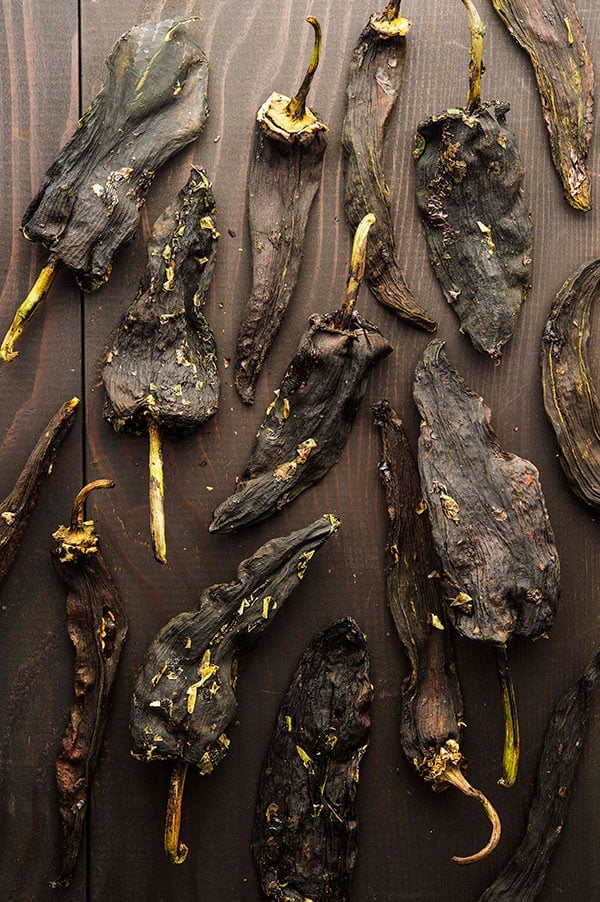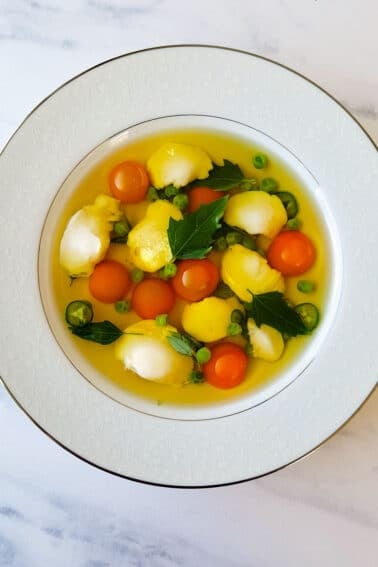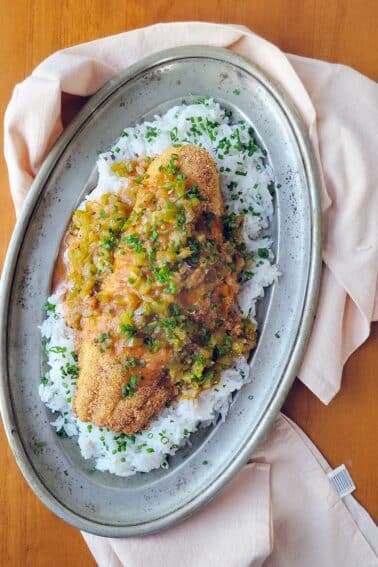As an Amazon Associate I earn from qualifying purchases.

I came across a reference to chile pasado in a Spanish language cookbook focusing on the foods of northern Mexico. What is that, I thought?
Turns out that chiles pasados are not only a cool way to preserve green chiles, it’s also a fantastic, lightweight dried food you can bring with you on camping or hunting trips.
Literally meaning “stale” or “worn” chiles, a chile pasado is basically a green chile, charred on the outside to blister and remove the skins, that is then dehydrated. You can do this with a dehydrator or you can do it the old fashioned way, by hanging the skinned chiles from their stems in the hot, breezy shade.
Chile pasado has its origin in the Mexican states of Chihuahua and Durango, and is believed to be pre-Columbian in origin, although the dried green chiles became excellent vaquero food for long, hot, dry cattle wrangling trips. If you can read Spanish, here’s a cool entry on the history of chiles pasados.
Why bother doing this? First, because it’s really interesting. Second, the dried chiles are light and portable. Third, no refrigeration necessary. Fourth, they taste great.
The rehydrated, fire-roasted green chiles, when added to tacos or included in tamales or in a guiso — a thick stew — are similar but different from their fresh cousins. Their texture is meatier, and the flavor more concentrated.
In theory, you can made a chile pasado from any chile, but traditionally you would use either poblanos or a Hatch-style chile, like an Anaheim. They can be either hot or mild.

How do I like my chile pasado? Well, it’s the most amazing component of a “dried stew,” an homage to the desert. Add it to carne seca, dried nopales, dried cholla buds, chiltepin chiles, and even dried onions or garlic powder. Add salt, and water, and you have an amazing feast out in the desert… or wherever you find yourself.
It is also amazing as the green chiles in my green chile mac and cheese recipe, as well as my New Mexican green chile stew.
Equipment
- Dehydrator
- String (optional)
- Plastic produce bags
Ingredients
- 10 green poblano or Hatch-style chile, like Anaheim
Instructions
- Roast the chiles. I do this over an open gas flame on my stovetop, but it's better done over a ragingly hot, smoky wood fire. You don't want to really cook the chiles, which is why I don't use my broiler or oven, but if this is all you have, go for it -- broil the chiles, turning often. I char the skins of the chiles over the open flame until they are almost universally black.
- When you've blackened each chile, put it in the produce bag to steam. When they're all done, let them steam in the bag until cool enough to work with. Remove the skins. I do this by scraping the skins off with a butter knife, from stem towards the point. Do not rinse the chiles, as this removes a lot of flavor.
- To dry your chiles, hang them by the stem with the string in a hot, airy, dry place, like a garage in summer, or under a porch. Do not sun dry them, as this will bleach the chiles. Shade is key. Alternatively, you can dry your chiles pasado in a dehydrator set at about 110F, more or less.
- There's a trick to this: The section of the chile closest to the stem will take a long time to fully dry. When you hang the chiles, it dries them more evenly. If you are dehydrating, you will need to turn the chiles over a few times. It can take a full day in a dehydrator, up to a week in open air.
Nutrition
Nutrition information is automatically calculated, so should only be used as an approximation.





Is heat required to dehydrate the chilis? I peeled and seeded mine and put them on a wire wrack to dry, immediately ran out of space and time, and stuck them in the refrigerator in the garage. I then promptly forgot about them. I finally remembered them more than two weeks later. They seem fine, just very dried out. I can’t imagine that are unsafe to eat, but I am curious how this affects them. Any thoughts or concerns about this?
Hatch: Sorta? I mean, yes, you can dry them in dry weather as cool as the 80s, but it’s better if you’re in the 90s or higher. I do agree that they dry best at low temps, less than 140F.
I don’t have a dehydrator and live on the Oregon coast, i.e. probably getting too cool for hanging outdoors. Can an oven substitute? Or a warm laundry room window? Thanks!
Kristin: For this, you’d want a low oven, as low as it will go, keeping the oven door ajar with a piece of bunched up foil.
Where can I buy this chili?
Kathy: You can’t. You have to make them.
I bought two bags back from my trip to alburqurque just recently at El Mezquite Market the owner there was a very helpful lady and was the one that told me about the chile pasado, you can buy from online I believe,
Do the have to be peeled?
Randy: Yes, that is what makes them chiles pasado. Otherwise they are just dried peppers.
I got the Chiles dried. Do you have a recipe for the dried stew you mentioned?
Thanks!
Jared: I do, but I haven’t posted it yet. For now, look up “chile pasado de Chihuahua” in Google and then use the translate function if you don’t read Spanish. That should get you started.
Do you have any thing on smoking chiles
Michael: I am working on it.
Great! I was wondering why all I ever see is dried red chiles. Every year at peak season, I fire roast, seed and peel anaheims & poblanos and freeze them for use during the winter months. This is a great alternative and I’ll be able to store them in jars in the pantry, just as I do red chiles. I love having a new preserving project. Thanks, Hank!
A Guatemalan lady gave me a tip on blistering chiles with near zero cooking. She uses a Bernzomatic propane blow torch! Quick and easy and almost no sweating required. Thank you, Tamaidy!! She was also quite impressed with your venison tamale recipe, Hank!!
I just roasted on an open fire (alder wood) and peeled two produce boxes of Anaheim chilies I purchased from the Yakima valley. I do this every year because I love them so much. I will have to try this.
I roast, peel, chop and can chiles. I also dry whole chiles. This would be a combination of both. Sounds interesting. Next time I am preserving, I’ll give this a try. Thanks for the tip.
Dan Dufore